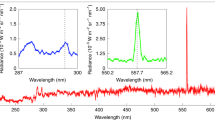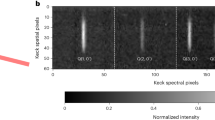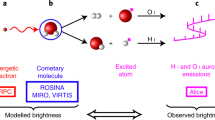Abstract
SINCE their detection in the high latitudes of Jupiter, first by the Voyager Ultraviolet Spectrometer (UVS) experiment1,2, then by the International Ultraviolet Explorer (IDE) satellite3, the auroral particle precipitations have been associated with various phenomena in the jovian environment. In the magnetosphere, the H+3 ion, probably of ionospheric origin, was detected in situ by the Voyagers4. Infrared emissions were observed in spectral bands characteristic of CH4 (ref. 5) and of other hydrocarbons6,7, localized in two auroral spots5,8. Here we present high-resolution spectra at a wavelength of 2 μm, in the southern auroral region of Jupiter, recorded at the Canada–France–Hawaii Telescope (CFHT), which we believe to be the first astronomical spectroscopic detection of H3+. The derived rotational temperature of H3+ is in the range 1,000–1,200 K. Such strong H3+ lines could be used in future ground-based monitoring of the jovian auroral activity and to search for this molecular ion in the interstellar medium.
This is a preview of subscription content, access via your institution
Access options
Subscribe to this journal
Receive 51 print issues and online access
$199.00 per year
only $3.90 per issue
Buy this article
- Purchase on Springer Link
- Instant access to full article PDF
Prices may be subject to local taxes which are calculated during checkout
Similar content being viewed by others
References
Broadfoot, A. L. et al. Science 204, 979–982 (1979).
Sandel, B. R. et al. Science 206, 962–966 (1979).
Clarke, J. T., Moos, H. W., Atreya, S. K. & Lane, A. L. Astrophys. J. 241, L179–L182 (1980).
Hamilton, D. C. et al. Geophys. Res. Lett. 7, 813–816 (1980).
Caldwell, J., Tokunaga, A. T. & Gillett, F. C. Icarus 41, 667–675 (1980).
Kim, S. J., Caldwell, J., Rivolo, A. R. & Wagener, R. Icarus 64, 233–248 (1985).
Drossart, P. et al. Icarus 66, 610–618 (1986).
Caldwell, J., Halthore, R., Orton, G. S. & Bergstrahl, J. Icarus 74, 331–339 (1988).
Trafton, L., Lester, D. F. & Thompson, K. L. Astrophys. J. (in the press).
Skinner, T. E. & Moos, H. W. Geophys. Res. Lett. 11, 1107–1110 (1984).
Crosswhite, H. M. The Hydrogen Molecule Wavelength Tables of Gerhard Heinrich Dieke (Wiley-Interscience, New York, 1972).
Herzberg, G. & Jungen, Ch. J. chem. Phys. 77, 5876–5884 (1982).
Senn, P., Quadrelli, P., Dressler, K. & Herzberg, G. J. chem. Phys. 83, 962–968 (1985).
Majewski, W. A., Marshall, M. D., McKellar, A. R. W., Johns, J. W. C. & Watson, J. K. G. J. molec. Spectrosc. 122, 341–355 (1987).
Majewski, W. A. & Watson, J. K. G. in 42nd Symposium on Molecular Spectroscopy (ed. Rao, K. N.) WF4 (Ohio State University, Columbus, 1987).
Carney, G. D. & Porter, R. N. J. chem. Phys. 65, 3547–3565 (1976).
Miller, S. & Tennyson, J. J. molec. Spectrosc. 128, 530–539 (1988).
Bawendi, M. G., Rehfuss, B. D. & Oka, T. 43rd Symposium on Molecular Spectroscopy (ed. Rao, K. N.) RA10 (Ohio State University, Columbus, 1988).
Watson, J. K. G. J. molec. Spectrosc. 103, 350–363 (1984).
Herzberg, G. Infrared and Raman Spectra of Polyatomic Molecules 509 (Van Nostrand, Princeton, 1945).
Quack, M. Mol. Phys. 34, 477–504 (1977).
Conrath, B. J. & Gierasch, P. J. Icarus 57, 184–204 (1984).
Atreya, S. K. Atmospheres and Ionospheres of the Outer Planets and Their Satellites, 121–142 (Springer, Berlin, 1986).
Theard, L. P. & Huntress, W. T. J. chem. Phys. 60, 2840–2848 (1974).
Amano, T. Astrophys. J. 329, L121–L124 (1988).
Leu, M. T., Bondi, M. A. & Johnsen, R. Phys. Rev. A8, 413–419 (1973).
Adams, N. G. & Smith, D. IAU Symp. No. 120: Astrochemistry (eds Vardya, M. S. & Tarufdar, S. P.) 1–18 (Reidel, Dordrecht, 1987).
Atreya, S. K. & Donahue, T. M. in Jupiter (ed. Gehrels, T.) 304–318 (University of Arizona Press, 1976).
Waite, J. H. Jr et al. J. geophys. Res. 88, 6143–6163 (1983).
Eshleman, V. R. et al. Science 208, 959–962 (1979).
McConnell, J. C. & Majeed, T. J. geophys. Res. 92, 8570–8578 (1987).
Author information
Authors and Affiliations
Rights and permissions
About this article
Cite this article
Drossart, P., Maillard, JP., Caldwell, J. et al. Detection of H3+ on Jupiter. Nature 340, 539–541 (1989). https://doi.org/10.1038/340539a0
Received:
Accepted:
Issue Date:
DOI: https://doi.org/10.1038/340539a0
This article is cited by
-
Moons and Jupiter Imaging Spectrometer (MAJIS) on Jupiter Icy Moons Explorer (JUICE)
Space Science Reviews (2024)
-
Insights into ultrafast H3+ formation provide a glimpse into primordial chemistry
Nature Chemistry (2023)
-
Detection of the infrared aurora at Uranus with Keck-NIRSPEC
Nature Astronomy (2023)
-
Jupiter Science Enabled by ESA’s Jupiter Icy Moons Explorer
Space Science Reviews (2023)
-
Calculation of the intermolecular potential energy surfaces of \({\mathbf{H}\mathbf{e}\mathbf{H}}_{3}^{+}\) by means of ab initio methods
Theoretical Chemistry Accounts (2022)
Comments
By submitting a comment you agree to abide by our Terms and Community Guidelines. If you find something abusive or that does not comply with our terms or guidelines please flag it as inappropriate.



